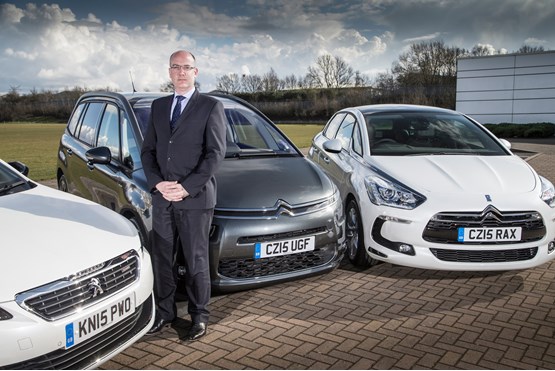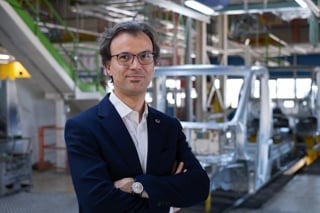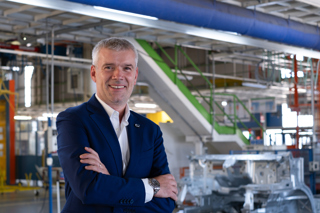 The Citroën C4 Cactus (best compact SUV at this year’s Fleet News Awards) and Grand C4 Picasso (best seven-seat people carrier for the second year in a row) play an important role in PSA Peugeot Citroën’s new cross-selling strategy.
The Citroën C4 Cactus (best compact SUV at this year’s Fleet News Awards) and Grand C4 Picasso (best seven-seat people carrier for the second year in a row) play an important role in PSA Peugeot Citroën’s new cross-selling strategy.
Peugeot and Citroën DS corporate sales managers are being targeted to develop opportunities for cross-selling for the brands.
It’s an odd situation for two brands which, until recently, were “fiercely independent”, according to director of fleet and used vehicles Martin Gurney. However, it’s indicative of the new direction PSA Peugeot Citroën is taking.
The two brands currently share 10% of corporate accounts. There is “an enormous opportunity” to grow that number, according to Gurney.
“I don’t think there is any limit to the opportunity of moving those shared accounts, currently 10%, to 100% ultimately. How long that is likely to take I wouldn’t like to say, but it’s a huge opportunity.”
Gurney believes cross-selling works because Peugeot and Citroën have products that are “in completely different places in the marketplace and in completely different parts of their lifecycle”.
“Our biggest focus for Citroën DS is to identify those Peugeot key accounts where we can sell some incremental product and, not by chance, C4 Cactus, C4 Picasso and Grand C4 Picasso are where we have a fantastic opportunity to do that because they are different or new and there are similar opportunities the other way for Peugeot to sell into Citroën and DS key accounts,” says Gurney.
“With DS we have an emerging premium brand, which is something different we can offer to traditional Peugeot customers without eroding the Peugeot volume we supply.”
Cross-selling fits well with Gurney’s channel mix improvement strategy – to move away from sales classed as ‘red channel’ (rental, courtesy cars and other short-cycle, low-margin deals) and to do more ‘green channel’ (true fleet) business.
“It’s firmly under the banner of channel mix improvement because it’s developing our sales to corporate accounts, which is where we want to be,” Gurney says.
Fleet News: Is your channel mix improvement strategy working?
Martin Gurney: It’s a progressive change. We will never achieve what we want to achieve overnight, but the general direction in which we’re moving is away from, where possible, the short-cycle business and more into developing our longer-term relationships with key accounts, with our lessors and with SMEs.
I am not saying we don’t do that business, but it’s a progressive plan to migrate away from it.
That strategy is key to responsible and sustainable growth, and when I say ‘responsible’ I mean it’s in our own interests and our customers’ interests when we talk about the protection of residual values. That is our core strategy.
The world is never perfect and clearly we’re under lots of commercial pressure all the time, but improving the mix of our business and protecting residual values is at the heart of everything that we do.
FN: Have you introduced any new initiatives to attract local businesses and SMEs?
MG: Citroën has got a long-standing business centre network, so a lot of the initiatives tend to be dealer-driven. We don’t mandate extended opening hours, but dealers will always work with their individual customers to offer what is required. For example, they will open early to service vehicles before the working day starts or weekend servicing as necessary.
One of the most significant changes we’ve made this year in terms of ramping up volume is with our Ready to Run programme. Citroën, through the business centre network, offers off-the-shelf conversions – tippers, dropsides and Lutons, typically. We’ve invested a lot of resource with the business centres to make those vehicles available from stock during 2015, so when a customer walks into a business centre they’re not having to wait eight weeks to get a vehicle converted.
FN: How have fleet operators reacted to the C4 Cactus?
MG: As you might imagine, given the unique styling of the car, it’s certainly provoked a lot of attention and opinion among our corporate accounts.
We have to accept it’s perhaps not suitable for every fleet as a result of that, but without a shadow of doubt most fleets have understood what we’re trying to achieve with C4 Cactus.
They admire the fact that we’ve dared to introduce a model that is that different and also cost-effective from the perspective of fleet operators.
We always appreciated there was going to be some difference of opinion with regards to the styling of the car to begin with, but, generally speaking, it’s been really positive and we’re starting to really gain some momentum.
FN: What do they think of the Airbump technology?
MG: Once we explain to fleet managers how it protects the vehicle and the money they are likely to save on refurbishment at defleet, they do see the benefit.
It’s early days, we’re only beginning to see the initial defleets of C4 Cactus, so we will see that develop as a business model. Fleet managers will be clear on what they typically spend on refurbishment and I’m sure it’s a reasonable amount of money for a lot of fleets.
FN: Is C4 Cactus more of a retail product?
MG: No, that’s the interesting thing. It’s about 70% fleet – that includes all fleet: captive, daily rental and true fleet. True fleet is by far the highest proportion, followed by limited daily rental and improving Motability performance. Public sector, salary sacrifice and perk cars have been the main sectors in true fleet. That’s because it has got fantastic total costs of ownership along with the fact that it’s different. It stands out, people notice it, and once we’ve got the first couple of cars into a customer, the order take begins to accelerate.
FN: What are your future sales expectations for C4 Cactus?
MG: We’d be delighted if we could repeat in the second half of the year our volumes from the first half and we’re certainly on track to do that. I fully anticipate that we will see double-digit growth from C4 Cactus as we move into 2016 and that will continue to be with a nice mix of retail, true fleet, captive and other fleet as well.
FN: What are your expectations for Grand C4 Picasso?
MG: It’s a different mix from Cactus, about 90% fleet, 10% retail. It’s a strong performer in Motability, true fleet is the second-biggest and on top of that we do some rental and other fleet. We expect to do a little bit better in the second half of the year.
In 2016, it would be nice to win the Fleet News best seven-seat people carrier award again. Assuming we do that, we’ve got every reason to believe we can repeat our 2015 sales in 2016, which will be a good achievement considering the car will be a year older.
We’ve got some interesting new technology coming on the vehicle as we move into 2016 that will give another reason for us to present the car to our customers and prospects.
FN: What best practice have you identified between Peugeot and Citroën?
MG: The way we manage our demonstrator programme is a good example. We had two separate suppliers for our fleet demonstrator programme, we now have one. That gives us efficiencies and enables us to invest more in the size of our demonstrator fleet and the choice we can offer to our customers. We’ve moved to the Citroën way of doing things.
Another good example is how we sign off support terms for customers and turn that into a fleet discount proposal i.e. a contract that goes to the customer. The Peugeot way of doing that was much slicker, so we’re moving towards that. It means there will be much less time lag between a corporate sales manager going to see a customer and agreeing support terms and the customer receiving the documentation.
Citroën will be focused on vans next year, with “some exciting new product coming” (likely the Dispatch), says Gurney.
Petrol engines will also feature in his plans: “I fully anticipate that at some point in the future we will see our three-cylinder PureTech engine available on LCV product. It will depend on customer demand. At the moment, two of our biggest LCV customers are trialling petrol to see how it works for them.
“If we start to see increased demand for petrol in LCV, that will be something we will be able to do.
“Certainly with the emergence of more and more clean city policies and the speculation surrounding emissions, I think fleets are keeping their eyes open.”



















Login to comment
Comments
No comments have been made yet.